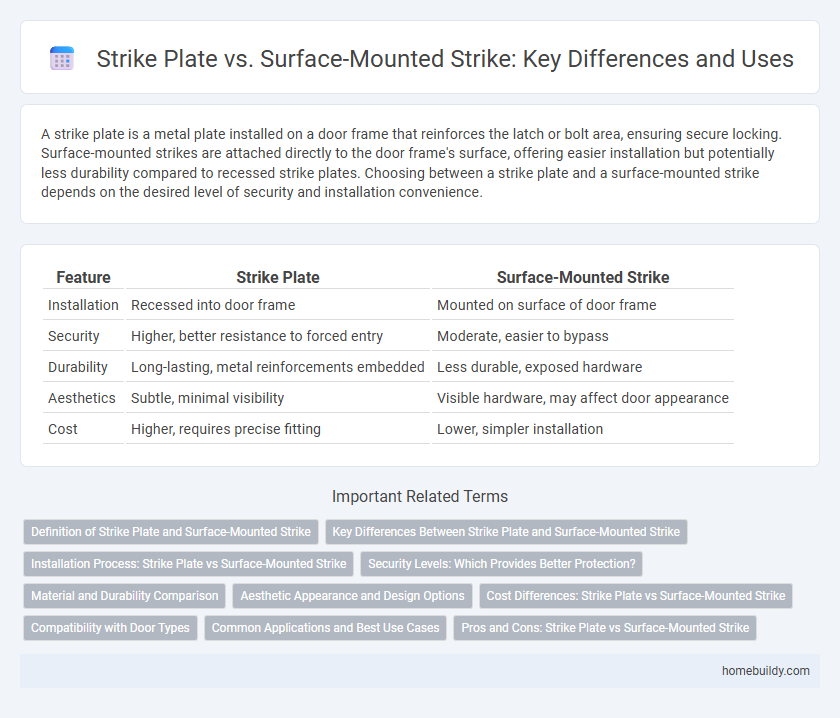A strike plate is a metal plate installed on a door frame that reinforces the latch or bolt area, ensuring secure locking. Surface-mounted strikes are attached directly to the door frame's surface, offering easier installation but potentially less durability compared to recessed strike plates. Choosing between a strike plate and a surface-mounted strike depends on the desired level of security and installation convenience.
Table of Comparison
| Feature | Strike Plate | Surface-Mounted Strike |
|---|---|---|
| Installation | Recessed into door frame | Mounted on surface of door frame |
| Security | Higher, better resistance to forced entry | Moderate, easier to bypass |
| Durability | Long-lasting, metal reinforcements embedded | Less durable, exposed hardware |
| Aesthetics | Subtle, minimal visibility | Visible hardware, may affect door appearance |
| Cost | Higher, requires precise fitting | Lower, simpler installation |
Definition of Strike Plate and Surface-Mounted Strike
A strike plate is a metal plate attached to a door frame that reinforces the latch or bolt hole, ensuring secure engagement when the door is closed. Surface-mounted strikes are installed on the surface of the door frame rather than being recessed, offering easier installation and compatibility with various door types. Both components improve door security, but the strike plate is typically embedded, while surface-mounted strikes are visible and accessible.
Key Differences Between Strike Plate and Surface-Mounted Strike
A strike plate is a metal plate embedded into the door frame to receive the latch or bolt, ensuring a secure lock connection, whereas a surface-mounted strike is installed directly onto the door frame's surface without recessing. Strike plates require precise mortising for flush installation, providing enhanced security and alignment, while surface-mounted strikes offer easier installation but may be less aesthetically pleasing and offer slightly reduced resistance to forced entry. The choice depends on installation complexity, security needs, and frame compatibility.
Installation Process: Strike Plate vs Surface-Mounted Strike
The installation process for a strike plate involves mortising the door frame to create a recessed cavity, ensuring the plate sits flush for secure latch engagement. Surface-mounted strikes require no mortising and attach directly onto the frame surface, simplifying installation but potentially protruding from the frame. Strike plates generally offer a more integrated, durable fit, while surface-mounted strikes prioritize ease and speed of installation.
Security Levels: Which Provides Better Protection?
Strike plates, typically recessed into the door frame, offer enhanced security by reinforcing the latch area and resisting forced entry more effectively than surface-mounted strikes, which are attached directly onto the frame surface. The recessed installation distributes impact forces, making it harder for intruders to pry open the door, while surface-mounted strike plates may be more vulnerable due to their exposed positioning and weaker anchoring. Choosing a strike plate with heavy-duty materials and longer screws further improves security levels over standard surface-mounted options.
Material and Durability Comparison
Strike plates are typically crafted from solid metals such as stainless steel or brass, offering high durability and resistance to wear and corrosion. Surface-mounted strikes, often made from lighter metals or alloys, may sacrifice some strength for easier installation but can be less durable under heavy use. Stainless steel strike plates outperform surface-mounted strikes in longevity and ability to withstand forced entry, making them preferable for high-security applications.
Aesthetic Appearance and Design Options
Strike plates offer a flush, integrated look that enhances door hardware aesthetics by blending seamlessly with the door frame, while surface-mounted strikes tend to be more visible and bulkier. Design options for strike plates include various finishes and sizes to match door hardware styles, providing a sleek and customized appearance. Surface-mounted strikes often prioritize functionality over design, limiting aesthetic flexibility compared to the more refined strike plate options.
Cost Differences: Strike Plate vs Surface-Mounted Strike
Strike plates generally offer a more cost-effective solution compared to surface-mounted strikes due to their simpler installation process and lower material requirements. Surface-mounted strikes, while often providing enhanced security and durability, tend to incur higher costs from additional hardware and labor-intensive fitting. Budget considerations typically favor strike plates for standard door applications, whereas surface-mounted strikes are preferred in high-security or heavy-use environments despite the elevated expense.
Compatibility with Door Types
Strike plates are designed for compatibility with various door types, typically used in mortise locks and ensuring precise alignment with latch bolts. Surface-mounted strikes offer more flexibility, fitting a wider range of door frames including metal, wooden, and aluminum, often ideal for retrofitting or upgrading existing doors. Choosing between a strike plate and a surface-mounted strike depends on door thickness, frame material, and lock type to guarantee secure installation and optimal function.
Common Applications and Best Use Cases
Strike plates are typically used in traditional door frames where the metal is recessed into the frame, providing a secure and flush fit ideal for interior and exterior doors with standard locksets. Surface-mounted strikes are commonly found in retrofit projects or where the door frame cannot be mortised, such as metal or aluminum frames, offering easier installation and adaptability for electric strike systems. Best use cases for strike plates favor residential and commercial wooden doors, while surface-mounted strikes excel in security gates, access control systems, and doors requiring quick installation without structural modification.
Pros and Cons: Strike Plate vs Surface-Mounted Strike
Strike plates are embedded into the door frame, providing a sleek appearance and enhanced security by reinforcing the latch area, but installation requires precise mortising and can be time-consuming. Surface-mounted strikes offer easier installation without the need for framing modifications and allow flexibility in placement, yet they can be more vulnerable to tampering due to their exposed position and often lack the flush finish of embedded strike plates. Choosing between the two depends on balancing aesthetic preferences, security requirements, and installation complexity.
Strike plate vs surface-mounted strike Infographic

 homebuildy.com
homebuildy.com